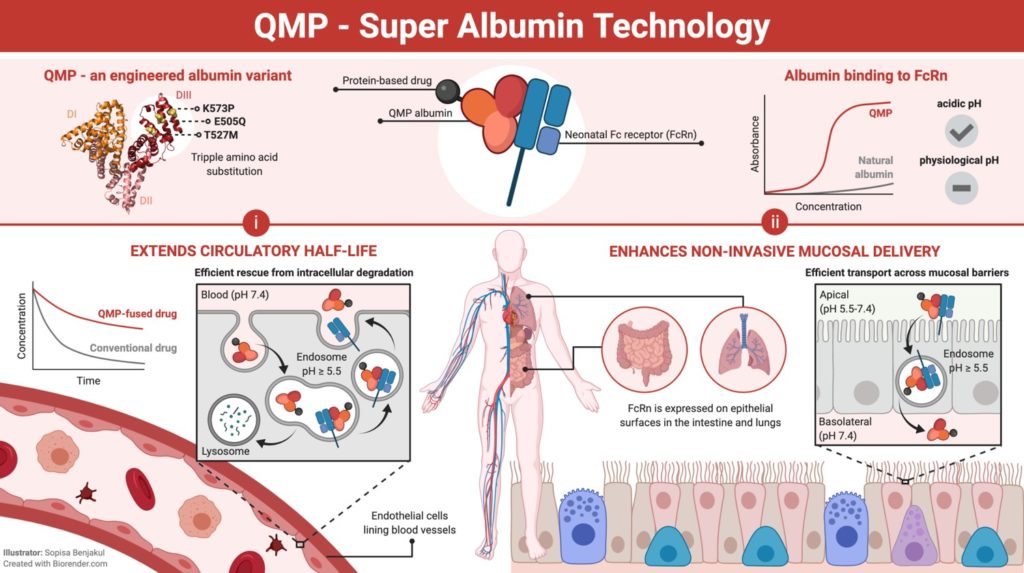Photo: Simone Mester.
Most protein-based therapeutics must be injected to be effective. That is both stressful for the patient and costly for the healthcare system. Researchers at the University of Oslo and Oslo University Hospital have recently published an article in the highly reputed journal Science Translational Medicine in which they show how their super albumin can solve the problem.
‘Albumin is an important carrier molecule in the human body, a veritable molecular taxi. In its many binding pockets, albumin transports hormones, metals, fatty acids and waste products from A to B,’ says Jan Terje Andersen.
He is Professor in Biomedical Innovation at the University of Oslo and is heading the Laboratory of Adaptive Immunity and Homeostasis. The group is affiliated to both the university and Oslo University Hospital.
For more than 15 years, Andersen and his colleagues have been conducting research on albumin and antibodies (see the fact box). Their in-depth biological understanding of these proteins has laid the foundation for the development of biomedical technologies that can be used to tailor the binding and transport properties of new protein-based therapeutics. Now it is super albumin’s turn.
‘Super albumin has many of the same properties as ordinary albumin, but it also has more. We have drawn on our fundamental understanding of why albumin remains in the bloodstream for longer than other proteins to design a human albumin variant that “surpasses nature itself”. Our super albumin has the ability to remain in the body for a long time, and it can therefore serve as an excellent taxi for fused protein-based therapeutics,’ Andersen explains.

Jan Terje Andersen. Photo: Inven2 / Moment Studio.
The research that resulted in super albumin and how it can be used for medical purposes was recently published in the highly reputed journal Science Translational Medicine. This interdisciplinary journal focuses on groundbreaking biomedical research and enabling technologies that can have clinical significance for the treatment of serious illnesses.
CAN BE DELIVERED AS A NASAL SPRAY
So, what makes super albumin so super?
‘Most protein-based therapeutics only have effect for a very limited time in the body. They are excreted via the kidneys or rapidly broken down in the liver or elsewhere in the body. They therefore have to be administered often, and in large doses. Other promising candidate therapeutics never reach the clinic due to their short duration of action. Hooking them up with super albumin substantially changes this picture. More of it remains in the body over time and more of it can reach its target,’ says Andersen.
Super albumin is also designed so that it can be absorbed and efficiently transported across the body’s mucosal barriers, for example in the lungs.
‘Super albumin fused to protein-based therapeutics can be administered via an inhalator or nasal spray. This ensures local delivery to for instance lung tissue, which can have several advantages in the treatment context. An added bonus is that the fused therapeutic molecule can also reach the bloodstream, thereby increasing its duration of action. The patients will not be dependent on invasive injections either, and they will not necessarily have to go to a hospital for treatment,’ Andersen says.
All in all, this is a big advantage for both patients and society at large. It may save time and resources as well as spare health budgets.
IN DIALOGUE WITH THE INDUSTRY
The properties of super albumin make it a highly attractive drug carrier for the biotech and pharmaceutical industry.
‘In cooperation with our team at Inven2, we are currently in dialogue with several companies. The technology we have developed is a versatile platform technology, as it can be used to improve the delivery and duration of action of many very different protein-based candidate therapeutics,’ says Andersen.
The team at Inven2 consists of Gerbrand Koster, who is project manager for Andersen’s projects, Eivind Roverud who is responsible for patenting and intellectual property rights, Kristin Sandereid who is in charge of business development and Helle Thorsen, who drafts contracts and agreements.
‘The super albumin that Andersen’s research group has developed is a really exciting, new biomedical concept for extending the lifetime and improving the delivery of bio-therapeutics. It can have many advantages compared with existing technologies. We are already in dialogue with a number of industry partners, and they will probably increase in number now that the research has been published in such a reputable journal,’ says Koster.

Illustration of QMP – Super Albumin technology.. Source: The Laboratory of Adoptive Immunity and Homeostasis, Oslo University Hospital.
IN COMPETITION WITH ANTIBODIES
Using albumin to increase the lifetime of therapeutics is not a new idea. The research group has been working on this for years. They patented the first generation of designed albumin 10 years ago. Super albumin takes the concept a big step further.
‘Our research indicates that, for certain indications, super albumin can be both more effective and safer in use than antibodies, for example for pregnant women. Research shows that antibodies of the IgG type are transported from the mother to the foetus via the placenta, while albumin does not. We do not know why this is the case, but it indicates that it may be an advantage to use albumin as a drug carrier, so that a mother can take the medicine without risking harming the foetus,’ Andersen says.
The research group is excited about what the future will bring, and they are looking forward to super albumin having clinical benefits.
‘We work at the intersection between basic research and translational research, and we seeking fruitful partnership with industry partners to realise the benefits of our technologies. Our top priority is to make a difference for patients,’ says Andersen, before adding:
‘Long-term, close cooperation with Inven2 is crucial if we are to succeed with our technology platforms. The innovation process can seem chaotic and demanding. We learn together and complement each other. We welcome different opinions, challenge each other and are open for discussions,’ says Andersen.
Of all the employees of the University of Oslo and the hospitals under the South-Eastern Norway Regional Health Authority, Andersen is one of the researchers who has most innovations registered with Inven2. So far, he has a share in 65 inventions, 11 patent families and 50 industry agreements. The research on super albumin can help to substantially increase these figures.
Read the article in “Science Translational Medicine” here.
Watch this animated film about Super Albumin:
Facts:
Antibodies:
Antibodies are proteins that are produced by white blood cells when foreign substances such as viruses and bacteria are detected in the body. The foreign substances consist of antigens, and the body produces antibodies that specifically target these, like a key in a lock. The body is therefore always packed with antibodies – we are talking billions – and they both circulate in the bloodstream and cover the mucosal surfaces.
Albumin is the body’s carrier molecule, and it carries a plethora of cargo including nutrients and waste products to be delivered to different cells and organs. It has a long plasma half-life, a unique property that makes it of interest in design of novel therapeutics.
Jan Terje Andersen’s group: The Laboratory of Adoptive Immunity and Homeostasis
Jan Terje Andersen is a molecular biologist who leads a research group of 15 researchers known as the Laboratory of Adoptive Immunity and Homeostasis. The group is part of both Oslo University Hospital and the University of Oslo. It has been built up in cooperation with Professor Inger Sandlie.
In 2020, Andersen was appointed Professor in Biomedical Innovation at the University of Oslo.
The research group has particular expertise in molecular design, focusing on antibodies and albumin. The group collaborate extensively with national and international academic labs as well as biotech and pharmaceuticals companies with the aim to develop new protein-based therapeutics targeting cancer, chronic diseases as well as infectious diseases. They have developed several biomedical technology platforms.
Andersen is one of the researchers with the most innovations registered with Inven2.



 Norsk
Norsk